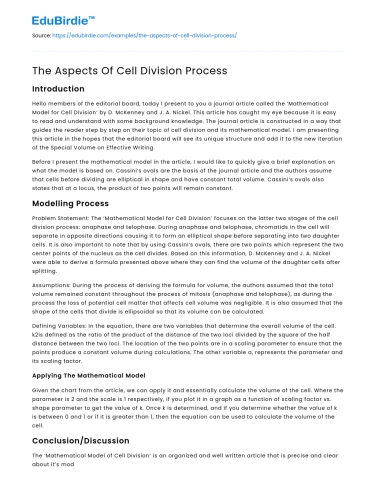Introduction
Hello members of the editorial board, today I present to you a journal article called the ‘Mathematical Model for Cell Division’ by D. McKenney and J. A. Nickel. This article has caught my eye because it is easy to read and understand with some background knowledge. The journal article is constructed in a way that guides the reader step by step on their topic of cell division and its mathematical model. I am presenting this article in the hopes that the editorial board will see its unique structure and add it to the new iteration of the Special Volume on Effective Writing.
Before I present the mathematical model in the article, I would like to quickly give a brief explanation on what the model is based on. Cassini’s ovals are the basis of the journal article and the authors assume that cells before dividing are elliptical in shape and have constant total volume. Cassini’s ovals also states that at a locus, the product of two points will remain constant.
Save your time!
We can take care of your essay
- Proper editing and formatting
- Free revision, title page, and bibliography
- Flexible prices and money-back guarantee
Modelling Process
Problem Statement: The ‘Mathematical Model for Cell Division’ focuses on the latter two stages of the cell division process: anaphase and telophase. During anaphase and telophase, chromatids in the cell will separate in opposite directions causing it to form an elliptical shape before separating into two daughter cells. It is also important to note that by using Cassini’s ovals, there are two points which represent the two center points of the nucleus as the cell divides. Based on this information, D. McKenney and J. A. Nickel were able to derive a formula presented above where they can find the volume of the daughter cells after splitting.
Assumptions: During the process of deriving the formula for volume, the authors assumed that the total volume remained constant throughout the process of mitosis (anaphase and telophase), as during the process the loss of potential cell matter that affects cell volume was negligible. It is also assumed that the shape of the cells that divide is ellipsoidal so that its volume can be calculated.
Defining Variables: In the equation, there are two variables that determine the overall volume of the cell. k2is defined as the ratio of the product of the distance of the two loci divided by the square of the half distance between the two loci. The location of the two points are in a scaling parameter to ensure that the points produce a constant volume during calculations. The other variable a, represents the parameter and its scaling factor.
Applying The Mathematical Model
Given the chart from the article, we can apply it and essentially calculate the volume of the cell. Where the parameter is 2 and the scale is 1 respectively, if you plot it in a graph as a function of scaling factor vs. shape parameter to get the value of k. Once k is determined, and if you determine whether the value of k is between 0 and 1 or if it is greater than 1, then the equation can be used to calculate the volume of the cell.
Conclusion/Discussion
The ‘Mathematical Model of Cell Division’ is an organized and well written article that is precise and clear about it’s modelling process and serves as a good example of what an article journal should look like. Although I did not understand what the Cassini’s ovals were, it did a good job explaining it in the context of calculating the total volume of cells during mitosis. It serves as a basis for future calculations regarding cell division and volume assuming the cell is elliptical. All in all, it would serve as an excellent addition to the upcoming Special Volume on Effective Writing, as it’s mathematical model makes it easy for readers to understand and apply it to their own research and writing.
Citations
- McKenny, D., and J. A. Nickel . Mathematical Model For Cell Division. Mathematical and Computer Modelling , Jan. 1997, www.sciencedirect.com/science/article/pii/S0895717797000058.






 Stuck on your essay?
Stuck on your essay?

